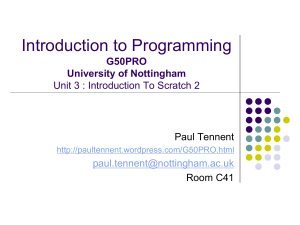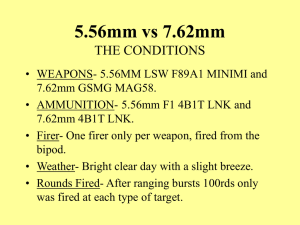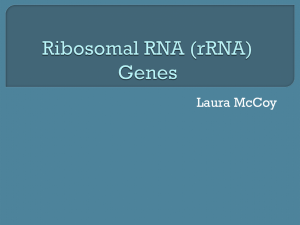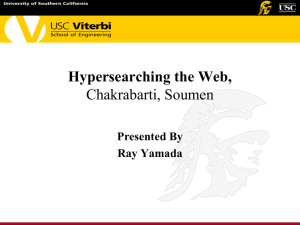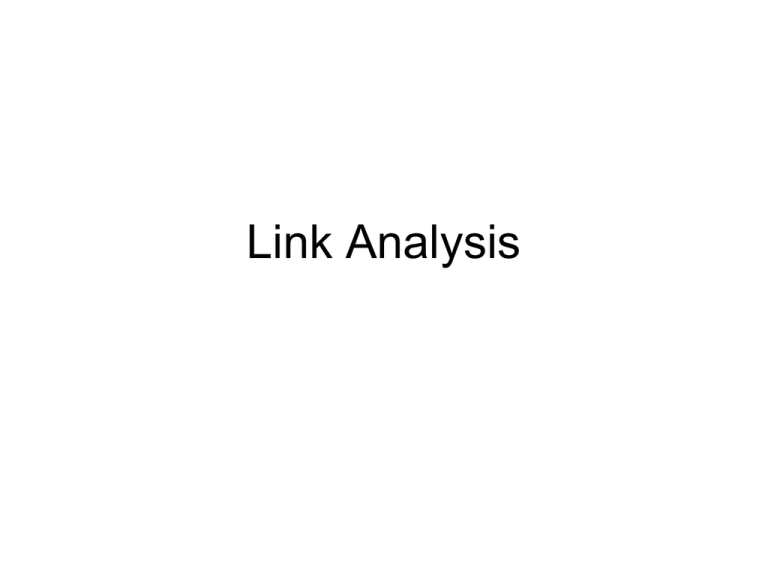
Link Analysis
Web Ranking
• Documents on the web are first ranked
according to their relevance vrs the query
• Additional ranking methods are needed to
cope with huge amount of information
• Additional ranking methods:
– Classification (manual, automatic)
– Link Analysis (today’s lesson)
Why link analysis?
• The web is not just a collection of documents –
its hyperlinks are important!
• A link from page A to page B may indicate:
– A is related to B, or
– A is recommending, citing, voting for or endorsing B
• Links are either
– referential – click here and get back home, or
– Informational – click here to get more detail
• Links affect the ranking of web pages and thus
have commercial value.
• The idea of using links is somehow “borrowed”
by citation analysis
Citation Analysis
• The impact factor of a journal = A/B
– A is the number of current year citations to articles
appearing in the journal during previous two years.
– B is the number of articles published in the journal
during previous two years.
Journal Title (AI)
J. Mach. Learn. Res.
IEEE T. Pattern Anal.
IEEE T. Evolut. Comp.
Artif. Intell.
Mach. Learn.
Impact Factor (2004)
5.952
4.352
3.688
3.570
3.258
Co-Citation
• A and B are co-cited by C, implying that they are
related or associated.
• The strength of co-citation between A and B is
the number of times they are co-cited.
Clusters from Co-Citation Graph
(Larson 96)
Citations vs. Links
• Web links are a bit different than citations:
– Many links are navigational.
– Many pages with high in-degree are portals,
not content providers.
– Not all links are endorsements (e.g. pointers to
“fake” conferences).
– Company websites don’t point to their
competitors.
However, the general idea that
“many citations = authority”
7
has been borrowed in link analysis
Link Analysis
• HITS (Hyperlink Induced Topic Serach)
Jon Kleinberg
• Page Rank Larry Page, Sergei Brin
Hyperlink Induced Topic
Search (HITS)
9
Main concept of the algorithm
• HITS stands for Hypertext Induced Topic Search.
• HITS is search query dependent.
• When the user issues a search query,
– HITS first expands the list of relevant pages returned
by a search engine and
– then produces two rankings of the expanded set of
pages, authority ranking and hub ranking.
10
Main concept of the algorithm-cont.
Authority: A authority is a page with many in-links.
– The idea is that the page may have good or
authoritative content on some topic and thus many
people trust it and link to it.
Hub: A hub is a page with many out-links.
– The page serves as an organizer of the information
on a particular topic and points to many good
authority pages on the topic (e.g. a portal).
11
HITS – Hubs and Authorities –
• A on the left is an authority
• A on the right is a hub
Description of HITS
• A good hub points to many good authorities, and
• A good authority is pointed to by many good
hubs.
• Authorities and hubs have a mutual
reinforcement relationship. The figure shows
some densely linked authorities and hubs (a
bipartite sub-graph).
13
The HITS algorithm: phase 1
• Given a broad search query, q, HITS
collects a set of pages as follows:
– It sends the query q to a search engine.
– It then collects t (t = 200 is used in the HITS
paper) highest ranked pages. This set is
called the root set W.
– It then grows W by including any page pointed
to by a page in W and any page that points to
a page in W. This gives a larger set S, base
set.
14
Expanding the Root Set
The link graph G
• HITS works on the pages in S, and assigns
every page in S an authority score and a hub
score.
• Let the number of pages in S be n.
• We use G = (V, E) to denote the hyperlink graph
of S.
• We use L to denote the adjacency matrix of the
graph.
1 if (i, j ) E
Lij
0 otherwise
16
Adjacency Matrix examples
The HITS algorithm (cont’d)
• Let the authority score of the page i be
a(i), and the hub score of page i be h(i).
• The mutual reinforcing relationship of
the two scores is represented as follows:
a(i)
h( j)
( j ,i )E
h(i)
a( j )
(i , j )E
18
HITS in matrix form
• We use a to denote the column vector with all the
authority scores,
a = (a(1), a(2), …, a(n))T, and
• use h to denote the column vector with all the”hub
scores“,
h = (h(1), h(2), …, h(n))T,
• Then, we can express previous formulas as:
a = LTh
h = La
• It is an equivalent formulation since the sum in previous
formula is for (i,j) in E, and L has 1 where there is a link
between i and j
19
Computation of HITS
• The computation of authority scores and hub
scores uses power iteration.
• If we use ak and hk to denote authority and hub
vectors at the kth iteration, the iterations for
generating the final solutions are
20
The HITS algorithm
h(0) :=
1)T
Initialize
•
(1, 1, …, Iterate
• k := 1
• Until convergence, do:
– a(k) := LT h(k-1)
(update a)
– h(k) := L a(k) (update h)
– a(k) := a(k)/||a(k)|| and h(k) := h(k)/||h(k)|| (normalize)
• Assignements can be re-wriiten as: :
– a(k) := LT h(k-1) = LT L a(k-1)
– h(k) := L a(k) = L LT h(k-1)
Meaning of the
T
T
L L and L L matrixes
• L is the adjacency matrix of the graph
• LT L is the authority matrix:
A = LT L =
Aij
=
LTik
i
Lkj
j
k
T
L i is pointed by all non-zero k
L
Lkj means that j is pointed by all non-zero k; LTik means that
n
n
Aij = å L Lkj = å Lki Lkj
k =1
T
ik
k =1
Aij is the number of co-citations, the
Number of nodes pointing to both i andj
..is this something youhave already seen???????
Convergence of HITS (power method)
• 1, 2, …, k are then eigenvalues of a matrix A (=LLT) and
|1| > |2| … |k|
• x1, …, xk are the eigenvectors and they are linearly independent (e.g. :
• 1x1+ 2x2 +…+kxk=0 iff 1=…=k=0)
• A generic vector v0 (h(0) o a(0)) can be re-written as:
– v0=1x1+ 2x2 +…+kxk
a(k) := LT L a(k-1)=A a(k-1)
• hence:
– v1=Av0=1Ax1+ 2Ax2 +…+kAxk=11x1+ 22x2 +…+kkxk=
– 1[1x1+ 2(2/1)x2 +…+k(k/1)xk]
"i : x i , li eigenvalue, eigenvector of A, A = li x i
• And in general:
– vm=Avm-1=Amv0=1Amx1+ 2Amx2 +…+kAmxk=11mx1+ 22mx2 +…+
kkmxk= 1m [1x1+ 2(2/1)mx2 +…+k(k/1)mxk]
• Since |i/1| < 1, i = 2, 3, …, n, we get:
lim
m ®¥
1
v = lim
m m
l1
m ®¥
1
l1m
Am v 0 = a1 x1
HITS: Example (1)
1 2
3
2
6
1
5
4
1 2
1æ1
ç
2ç0
ç
3ç0
LT L = ç
4 çç 0
ç
5ç0
ç
6è0
3
4
5
6
0
0
0
0
0
0
0
0
0
2
1
1
0
1
1
0
0
1
0
3
0
0
0
0
0ö
÷
0÷
÷
0÷
÷
0 ÷÷
÷
0÷
÷
0ø
Ex: 3 and 4 are “co-cited” by 5
3
4
5
6
0
1
0
1
0
0
0
0
0
0
0
1
0
0
0
0
0
1
1
0
0
0
0
1
0ö
÷
0÷
÷
0÷
÷
0 ÷÷
÷
0÷
÷
0ø
1 2
3
4
5
6
0
1
0
1
1
0
0
0
0
1
0
0
0
0
0
0
0
0
0
2
0
1
0
0
1ö
÷
0÷
÷
1÷
÷
0 ÷÷
÷
0÷
÷
1ø
1æ0
ç
2ç1
ç
3ç0
L= ç
4 çç 0
ç
5ç0
ç
6è0
1æ2
ç
2ç0
ç
3ç1
LLT = ç
4 çç 0
ç
5ç1
ç
6è1
3 and 1 co-cite 5”
–a(1) := LT h(0)
HITS: Example (2)
–h(1) := L a(1)
3
1
2
3
6
5
1
2
authorities
æ 0.258 ö
ç
÷
ç 0 ÷
ç
÷
ç 0.516 ÷
ç
÷
ç 0.258 ÷
ç
÷
ç
÷
ç 0.775 ÷
ç
÷
è 0 ø
1 2
=
1æ0
ç
2ç1
3ç0
ç
4 ç0
5ç0
ç
6è0
3
4
5
0
1
0
1
0
0
0
0
0
0
0
1
0
0
0
0
0
1
1
0
0
0
0
1
6
5
hubs
4
a1
6
4
h0
æ 1ö
ç ÷
T
ö
0
÷ ç 1÷
0÷ ç ÷
0 ÷ ç 1÷
÷ ç ÷
0÷ ç ÷ =
1
0÷ ç ÷
÷
0 ø ç 1÷
ç ÷
ç ÷
è 1ø
(normalization step is not shown)
1
1æ0
ç
2ç1
ç
3ç0
ç
4 çç 0
ç
5ç0
ç
6è0
2
0
3
1
4
0
5
1
0
0
0
0
0
0
0
1
0
0
0
0
0
1
1
0
0
0
0
1
a1
6
0 öæ 0.258 ö
֍
÷
0 ÷ç 0 ÷
֍
÷
0 ÷ç 0.516 ÷
֍
÷=
÷
ç
0 ÷ç 0.258 ÷÷
֍
÷
0 ÷ç 0.775 ÷
֍
÷
0 øè 0 ø
h1
æ 0.687 ö
ç
÷
ç 0.137 ÷
ç
÷
ç 0.412 ÷
ç
÷
ç 0 ÷
ç
÷
ç
÷
0
.
412
ç
÷
ç
÷
0
.
412
è
ø
–a(2) := LT h(1)
HITS: Example (3)
–h(2) := L a(2)
3
1
2
3
6
5
1
2
authorities
1æ0
ç
2ç1
ç
3ç0
ç
4 çç 0
ç
5ç0
ç
6è0
3
4
5
0
1
0
1
0
0
0
0
0
0
0
1
0
0
0
0
0
1
1
0
0
0
0
1
6
h1
5
hubs
4
1 2
6
4
a2
T
0 ö æ 0.687 ö æç 0.072 ö÷
÷
֍
ç
÷
0 ÷ çç 0.137 ÷÷ ç 0 ÷
÷
÷
ç
÷ ç
0 ÷ ç 0.412 ÷ ç 0.573 ÷
÷
=
ç 0 ÷ ç 0.215 ÷
÷
0÷ ç
÷
÷ ç
÷
÷ ç
֍
0 ÷ ç 0.412 ÷ ç 0.788 ÷
÷
÷ ç
֍
0 ø è 0.412 ø è 0 ø
1
1æ0
ç
2ç1
ç
3ç0
ç
4 çç 0
ç
5ç0
ç
6è0
2
0
3
1
4
0
5
1
0
0
0
0
0
0
0
1
0
0
0
0
0
1
1
0
0
0
0
1
a2
6
0 öæ 0.072 ö
֍
÷
0 ÷ç 0 ÷
֍
÷
0 ÷ç 0.573 ÷
֍
÷=
÷
ç
0 ÷ç 0.215 ÷÷
֍
÷
0 ÷ç 0.788 ÷
֍
÷
0 øè 0 ø
h2
æ 0.706 ö
ç
÷
ç 0.037 ÷
ç
÷
ç 0.409 ÷
ç
÷
ç 0 ÷
ç
÷
ç
÷
0
.
409
ç
÷
ç
÷
0
.
409
è
ø
HITS: Example (4)
–a(3) := LT h(2)
–h(3) := L a(3)
3
1
2
3
6
5
1
2
authorities
1æ0
ç
2ç1
ç
3ç0
ç
4 çç 0
ç
5ç0
ç
6è0
3
4
5
0
1
0
1
0
0
0
0
0
0
0
1
0
0
0
0
0
1
1
0
0
0
0
1
6
h2
5
hubs
4
1 2
6
4
a3
T
0 ö æ 0.706 ö æç 0.019 ö÷
÷
֍
ç
÷
0 ÷ çç 0.037 ÷÷ ç 0 ÷
÷
÷
ç
÷ ç
0 ÷ ç 0.409 ÷ ç 0.577 ÷
÷
=
ç 0 ÷ ç 0.212 ÷
÷
0÷ ç
÷
÷ ç
÷
÷ ç
֍
0 ÷ ç 0.409 ÷ ç 0.789 ÷
÷
÷ ç
֍
0 ø è 0.409 ø è 0 ø
1
1æ0
ç
2ç1
ç
3ç0
ç
4 çç 0
ç
5ç0
ç
6è0
2
0
3
1
4
0
5
1
0
0
0
0
0
0
0
1
0
0
0
0
0
1
1
0
0
0
0
1
a3
6
0 öæ 0.019 ö
֍
÷
0 ÷ç 0 ÷
֍
÷
0 ÷ç 0.577 ÷
֍
÷=
÷
ç
0 ÷ç 0.212 ÷÷
֍
÷
0 ÷ç 0.789 ÷
֍
÷
0 øè 0 ø
h3
æ 0.707 ö
ç
÷
ç 0.001 ÷
ç
÷
ç 0.408 ÷
ç
÷
ç 0 ÷
ç
÷
ç
÷
0
.
408
ç
÷
ç
÷
0
.
408
è
ø
HITS: Esempio (5)
–a(4) := LT h(3)
–h(4) := L a(4)
3
1
2
3
6
5
1
2
authorities
1æ0
ç
2ç1
ç
3ç0
ç
4 çç 0
ç
5ç0
ç
6è0
3
4
5
0
1
0
1
0
0
0
0
0
0
0
1
0
0
0
0
0
1
1
0
0
0
0
1
6
h3
5
hubs
4
1 2
6
4
a4
T
0 ö æ 0.707 ö æç 0 ö÷
÷
֍
ç
÷
0 ÷ çç 0.001 ÷÷ ç 0 ÷
÷
÷
ç
÷ ç
0 ÷ ç 0.408 ÷ ç 0.577 ÷
÷
=
ç 0 ÷ ç 0.211 ÷
÷
0÷ ç
÷
÷ ç
÷
÷ ç
֍
0 ÷ ç 0.408 ÷ ç 0.789 ÷
÷
÷ ç
֍
0 ø è 0.408 ø è 0 ø
1
1æ0
ç
2ç1
ç
3ç0
ç
4 çç 0
ç
5ç0
ç
6è0
2
0
3
1
4
0
5
1
0
0
0
0
0
0
0
1
0
0
0
0
0
1
1
0
0
0
0
1
a4
6
0 öæ 0 ö
֍
÷
0 ÷ç 0 ÷
֍
÷
0 ÷ç 0.577 ÷
֍
÷=
÷
ç
0 ÷ç 0.211 ÷÷
֍
÷
0 ÷ç 0.789 ÷
֍
÷
0 øè 0 ø
h4
æ 0.707 ö
ç
÷
ç 0 ÷
ç
÷
ç 0.408 ÷
ç
÷
ç 0 ÷
ç
÷
ç
÷
0
.
408
ç
÷
ç
÷
0
.
408
è
ø
Strengths and weaknesses of HITS
• Strength: its ability to rank pages according to
the query topic, which may be able to provide
more relevant authority and hub pages.
• Weaknesses:
– It is easily spammed. It is in fact quite easy to
influence HITS since adding out-links in one’s own
page is so easy.
– Topic drift. Many pages in the expanded set may not
be on topic.
– Inefficiency at query time: The query time evaluation
is slow. Collecting the root set, expanding it and
performing eigenvector computation are all
expensive operations
29
Applications of HITS
•
•
•
•
•
Search engine querying (speed an issue)
Finding web communities.
Finding related pages.
Populating categories in web directories.
Citation analysis.
Link Analysis
• HITS (Hyperlink Induced Topic Serach)
Jon Kleinberg
• Page Rank Larry Page, Sergei Brin
Page Rank
• Ranks pages by authority.
• Applied to the entire web rather than a local
neighborhood of pages surrounding the results
of a query.
• Not query-dependent
• It is the Google algorithm for ranking pages
PageRank----Idea
Every page has some number of outlinks and in-links
PageRank----Idea
Two cases PageRank is interesting:
1. Web pages vary greatly in terms of the number of
backlinks (in-links) they have. For example, the
Netscape home page has 62,804 backlinks
compared to most pages which have just a few
backlinks. Generally, highly linked pages are
more “important” than pages with few links.
EUGENE GARFIELD, FRANCIS NARIN, AND PAGERANK: THE THEORETICAL
BASES OF THE GOOGLE SEARCH ENGINE
PageRank----Idea
2. Backlinks coming from important pages
convey more importance to a page. For
example, if a web page has a link off the Yahoo
home page, it may be just one link but it is a
very important one.
A page has high rank if the sum of the
ranks of its incoming links is high. This
covers both the case when a page has
many in-links and when a page has a few
highly ranked in-links.
PageRank----Definition
u: a web page
Fu: set of pages u points to
Bu: set of pages that point to u
Nu=|Fu|: the number of links from u
c: a factor used for normalization
R (v )
R(u) c
vBu N v
The equation is recursive, but it may be
computed by starting with any set of ranks and
iterating the computation until it converges.
0
0
1
0
Parto da pesi casuali
0
0
0
1
informatica@sapienza
Pagina 38
0,5
0
0,5
0
informatica@sapienza
informatica@sapienza
Pagina 39
Pagina 39
0
0,25
0
0,75
informatica@sapienza
informatica@sapienza
Pagina 40
Pagina 40
After several iterations..
0,22
0,11
0,22
0,44
Why stops here?
informatica@sapienza
informatica@sapienza
Pagina 41
Pagina 41
A probabilistic interpretation of
PageRank
The definition corresponds to the probability
distribution of a random walk on the web graphs.
What is a Random Walk?
• Given a graph and a starting point (node),
we select a neighbor of it at random, and
move to this neighbor;
• Then we select a neighbor of this node
and move to it, and so on;
• The (random) sequence of nodes selected
this way is a random walk on the graph
An example
Transition matrix P
Adjacency matrix A
B
1
1
1
1
A
1
C
1
1/2
1/2
Slide from Purnamitra Sarkar, Random Walks on Graphs: An Overview
44
An example
1
t=0, A
B
1/2
1
A
1/2
C
Slide from Purnamitra Sarkar, Random Walks on Graphs: An Overview
45
An example
1
B
1/2
1
A
1/2
t=1, AB
t=0, A
C
1
1
1/2
1/2
Slide from Purnamitra Sarkar, Random Walks on Graphs: An Overview
46
An example
B
1
1/2
1
A
1/2
t=1, AB
t=0, A
1
1
1/2
1/2
C
t=2, ABC
1
1
1/2
1/2
Slide from Purnamitra Sarkar, Random Walks on Graphs: An Overview
47
An example
B
1
1/2
1
A
1/2
t=1, AB
t=0, A
1
1/2
C
t=2, ABC
1
1
1/2
1
1/2
t=3, ABCA
ABCB
1
1
1/2
1/2
1/2
Slide from Purnamitra Sarkar, Random Walks on Graphs: An Overview
48
Probabilistic interpretation
• S total number of web pages
• k outgoing links from page j
• P Transition matrix with elements:
ì1 / k if i ® j
ï
Pij = í0
ï
î Pii > 0 "i
• The PageRank formulation can be written
as:
How to compute the vector r of
page ranks?
• The random surfer (or random walks)
model can be represented using
Markov Chains
Markov Chains (1)
• A Markov Chain consists in n states (let S the set of
possible states), and a matrix of transition probabilities
nn, P.
• At each step, the system is precisely in one state.
• For 1 i,j n, P(sisj) =Pij is the probability of
jumping to sj, given we are in si.
• Furthermore, if Xk is the random variable indicating the
state s reached at time tk (X gets values in S) , then:
P(Xk /X1,X2,… Xk-1)=P(Xk /Xk-1)
• The value of X at time k depends only from the value
of the random variable at time k-1! (This is the basic
property of Markov Chains)
Markov chains (2)
• Clearly
n
å
j =1
Pij = 1.
• Markov Chains are a model of random walks .
Probability Vectors
• Let x(t) = (x1, … xn) be an S-dimensional vector
indicating the state reached at time t
• Ex: (000…1…000) means we are in si.
s1
si
sn
But since we are modeling a stochastic process,
we must rather consider a vector of probabilities
x(t)=(P(s1), … P(sn))= (x1, … xn), indicating that at step
t the walk will bring to state si with probability xi, and
n
åx
i =1
i
= 1.
Ergodic Markov Chains
• A Markov Chain is ergodic if:
– There is a path between any pair of states
– Starting from any state, after a transition
time T0, the probability to reach any other
state in a finite time T>T0 is always different
from zero.
– Note: not true for the web graph!
Ergodic Chains
• If a Markov Chain is ergodic, every
state has a stationary probability of
being visited, regardless of the initial
state of the random walker .
– The vector x(t) of state probabilities
converges to a stationary vector r as
t ∞
Computing State Probability Vector
• If x(k) = (x1, … xn) is the vector x(t) in step t=k,
how would it change after the next jump?
• The adjacency matrix P tells us where we are
likely to jump from any state (since it has all
transition probabilities from si to the other linked
states):
• Therefore, from x(k) , the probability of next state
x(k+1 ) is computed according to: (x(k+1) = Px(k) )
• If the process is ergodic, x will converge to a
vector r such that r=Pr
• Since P is a matrix and r is a vector, which
vector is r??
Again: the Power method
• x(k+1) =Px(k)
• The sequence of vectors xk converge to the
stationary vector r
• To compute r we use the same method as for HITS
é
ù
• x (k+1) =xPk=x(k)P = l1k êa1v1 + a 2 ( l2 )k v2 + ...+ a n ( ln )k v n ú
l1
l1
ë
û
• The method converges provided there is a dominant
(principal) eigenvector
• Since the stationary condition is: r=rP, r is the
principal eigenvector of P
• Remember definition of eigenvectors!
Example
The normalized adjacency matrix P
P
1/N(ui)
Iterations
x(k+1) =Px(k)
x0 x1 x2
x3
x4
x60
x611
Recap: Pagerank
• Simulate a random surfer by the power
iteration method
• Problems
1. 0 pagerank if there are no incoming links or if
there are sinks
2. Not unique if the graph is disconnected
3. Computationally intensive?
4. Stability & Cost of recomputation (web is
dynamic)
5. Does not take into account the specific query
6. Easy to fool
Problem 1: Rank Sink
If two web pages point to each other but to
no other page, during the iteration, this
loop will accumulate rank but never
distribute any rank.
Rank Sink
• Problem: Pages in a loop accumulate rank but
do not distribute it.
• Solution: Teleportation, i.e. with a certain
probability the surfer can jump to any other web
page to get out of the loop.
Definition modified (with teleporting)
R (v )
R(u ) c
cE(u )
vBu N v
• E(u) is some vector of probabilities over the
web pages (for example uniform prob., favorite
page etc.) that corresponds to a source of rank.
c is the dumping factor.
• E(u) can be thought as the random surfer gets
bored periodically and jumps to a different page
and is not kept in a loop forever.
Note: “c” is the dumping factor
Teleporting
• This solves:
– Sink problem (problem 1)
– Disconnectedness (problem 2)
– Converges fast if w is chosen appropriately
(problem 3??)
• We still have problems:
1.Still computationally intensive?
2.Stability & Cost of recomputation (web is
dynamic)
3.Does not take into account the specific query
4.Easy to fool
The Largest Matrix Computation
in the World
• Computing PageRank can be done via
matrix multiplication, where the matrix has
3 billion rows and columns.
• The matrix is sparse as average number
of outlinks is between 7 and 8.
• Setting c = 0.15 or above requires at most
100 iterations to convergence.
• Researchers still trying to speed-up the
computation.
Monte Carlo Methods in
Computing PageRank
• Rather than following a single long random walk, the
random surfer can follow many sampled random
walks.
• Each walk starts at a random page and either
teleports with probability c or continues choosing a
link with uniform probability.
• The PR of a page is the proportion of times a
sample random walk ended at that page.
• Rather than starting at a random page, start each
walk a fixed number of times from each page.
Personalised PageRank
R(v)
R(u) = c å
+ cv
vÎBu N v
• Change cE(v) with cv
• Instead of teleporting uniformly to any page we
bias the jump prefer some pages over others.
– E.g. v has 1 for your home page and 0 otherwise.
– E.g. v prefers the topics you are interested in.
Weblogs influence on
PageRank
• A weblog (or blog) is a frequently updated web site on a
particular topic, made up of entries in reverse
chronological order.
• Blogs are a rich source of links, and therfore their links
influence PageRank.
• A “google bomb” is an attempt to influence the ranking
of a web page for a given phrase by adding links to the
page with the phrase as its anchor text.
• Google bombs date back as far as 1999, when a search
for "more evil than Satan himself" resulted in the
Microsoft homepage as the top result
Agoogle bombs
Link Spamming to Improve
PageRank
• Spam is the act of trying unfairly to gain a
high ranking on a search engine for a web
page without improving the user
experience.
• Link farms - join the farm by copying a
hub page which links to all members.
• Selling links from sites with high
PageRank.

